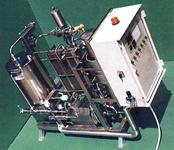2011 /2012
Joghurterzeugung
Jahrgang
Projektpartner
Lummerstorfer Josef
Maturanten

Knögler Andreas
5AAT

Lummerstorfer Benedikt
5AAT
Betreuer

Felhofer Hubert

Nößlböck Gregor
Seit ungefähr 19 Jahren erzeugt die Familie Lummerstorfer ihr eigenes Joghurt und liefert dieses an unterschiedliche Großküchen aus. Zum Erzeugen des Joghurts sind zwei wesentliche Schritte maßgebend.Im ersten Teil der Joghurterzeugung wird die Milch pasteurisiert. Im zweiten Schritt wird das fertige Naturjoghurt hergestellt. Für diese beiden maßgebenden Schritte muss Wasser auf hohe Temperaturen von ca. 85°C erhitzt werden. Zurzeit werden die Milch und das Joghurt mit elektrischer Energie erhitzt wodurch immens hohe Stromkosten entstehen.Die Aufgabe unseres Projektes besteht darin, den Milchpasteur und den Joghurtkessel von einer elektrischen Heizung auf die vorhandene Hackschnitzelheizung umzurüsten. Das Ziel ist es, durch das Umrüsten auf eine Hackschnitzelheizung eine große Menge an Stromkosten einzusparen, wobei sich die Kosten des Umbaus nach einer gewissen Zeit mit den ersparten Stromkosten amortisieren sollen.
Die Temperaturen, welche maßgeblich für beide Schritte sind, sollen durch Sensoren erfasst werden. Durch die Sensorik und die entsprechenden Steuerelemente soll sichergestellt werden, dass die richtige Temperatur eingehalten wird. Eine weitere Aufgabe ist es alle wichtigen Messdaten aufzuzeichnen. Es soll dem Bediener der Anlage möglich sein, alle wichtigen Messdaten abzurufen ohne ständig direkt an der Anlage zu sein.
Die Programmierung und die Regelung der Temperatur, welches der Kernpunkt des Projektes ist, erfolgt mittels einer S7-1200 der Firma Siemens. Sollte es ein Problem mit der Hackschnitzelheizung geben, so sollte man die elektrische Heizung in Betrieb nehmen können.
Die gesamte Anlage soll so umgerüstet werden, dass sie wieder auf den Originalzustand umgerüstet werden kann. Die Fertigung der gesamten Teile, welches hauptsächlich Rohrleitungen betrifft, wird dabei nicht in der Schule stattfinden.
Since several years the family Lummerstorfer is producing their own yoghurt and sells it to different facilities. To produce their own yoghurt they need two different machines.The first machine is the milk pasteurizer.In the milk pasteurizer the milk is heated electrically. This machine heats the fresh milk to a temperature of 72 to 75 degrees. To heat the milk the pasteurizer uses a plate heat exchanger. At first the water gets heated with the electrical power. In the plate heat exchanger the milk is heated by the warm water. In one hour the milk pasteurizer heats about 500 litres milk. The holding time of this temperature is about 15 to 30 seconds. The pasteurizer works with a pressure of 1 to10 bar. The whole plant has a power of about 9 kilowatts. It is very important that the materials of the milk pasteurizer are made out of stainless steel because of the tidiness. This process is necessary because of the bacteria which are in the milk before the pasteurization. After this process the milk is eatable for a longer time.Our task is to rebuild the machine so, that the milk can be heated with the existing woodchip heater.The second machine is the yoghurt boiler.The temperature of the milk has to be about 70 to 74 degrees. The yoghurt boiler should also be heated with the existing woodchip heater. When the yoghurt has reached the correct temperature it is very important to cool down the yoghurt to a temperature of about 40 degrees. To cool down the yoghurt we have to install an own cooling circuit. After the yoghurt has reached the temperature of about 40 degrees the so-called cultures come into the yoghurt. These cultures are necessary that the yoghurt gets the right thickness.
The whole control of this process is working with the help of a PLC. This PLC controls all important temperatures. If the temperature of the milk or the yoghurt is not right the PLC regulates the right temperature with the help of a two level controller. The PLC also controls all pumps and valves.
We have to install the whole electrics and all the pipes which are necessary.It is also very important to save all information. For this we use a webserver. The PLC sends the information to the webserver. Later you can call up all information via the network.


